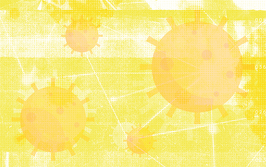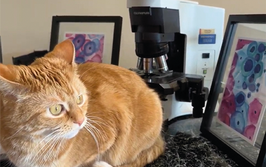
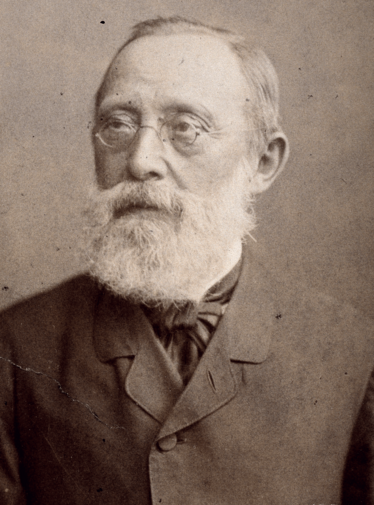
“Rudolf Virchow Photograph by J. C. Schaarwächter” by Julius Cornelius Schaarwächter is licensed under CC BY 4.0.
Rudolf Virchow was born on October 13, 1821, in Schievelbein, Kingdom of Prussia – a small town known today as Świdwin in northwestern Poland. Medical textbooks refer to Virchow as “the father of modern pathology” – a neat summation of his many roles in the discipline. He is also known as the founder of cell pathology, pathophysiology, the modern histopathology of tumors, public health in Germany, social medicine, and several other aspects of contemporary medical science and practice.
This year, we celebrate the 200th anniversary of this Renaissance man’s birth. Virchow wrote more than 2,000 articles and multi-volumed books in the best German academic tradition and the literature about him is equally voluminous – so, although it is impossible to fully present a man of his complex stature, it is our hope to introduce you a little to the father of our discipline.
Eponyms
Virchow always complained about the frequent mispronunciations of his surname. Yet this name has now been immortalized as an anatomic structure (the Virchow-Robin spaces around the blood vessels of the brain), a clinicopathologic finding (Virchow’s node, the supraclavicular lymph node involved in metastatic gastric carcinoma), and a pathophysiologic concept (Virchow’s triad – the determinants of thrombosis).
An astute student of medical history might notice that Virchow may not himself have described or coined the many concepts linked to him – but he undoubtedly lent credibility to the terms, ensured their acceptance by the medical establishment, and contributed to their two-century-long survival. His name is still on Virchows Archiv, the official journal of the European Society of Pathology (which he also founded). There several “Virchow’s awards” handed out annually and a number of “Virchow societies” for interested parties to join. Campus Virchow-Klinikum in Berlin and Rudolf Virchow Institute of Würzburg University memorialize two places he worked as a professor. The crowning glory, however, is an honor reserved for Virchow alone among pathologists – a lunar crater that, in 1979, was named after him.
Cellular pathology
As a young pathologist, Virchow became interested in microscopy and, ultimately, came to the conclusion that all processes in the body – including diseases – can be best explained in terms of normal or abnormal function of its constituent cells. In 1855, at the age of 34, he wrote that every cell originates from another cell (in Latin, “omnis cellula e cellula” ). This established the era of modern cytopathology.
Historians have shown that Virchow was not the first to come up with the idea of cell theory – yet no earlier publication had such a profound effect on pathology as his 1858 book, Die Cellularpathologie in ihrer Begründung auf physiologische und pathologische Gewebenlehre (Cellular Pathology as Based Upon Physiological and Pathological Histology). This impressive volume, containing 20 lectures delivered over a period of four months in Berlin’s newly built Institute of Pathology, not only transformed medicine, but also established microscopy as the principal tool of pathology for many years to come. It is still considered one of the most foundational books in modern medicine.
Anatomic pathology
Virchow advocated not only microscopy, but also a systematic study of diseases at autopsy. Using this approach, he thought that physicians could define specific diseases more precisely and thus diagnose them more accurately. He wrote that physicians should learn from their own mistakes and believed that, by using autopsy data, physicians could improve their practice, therapy, and even prognosis. In many of his speeches, Virchow stated that the practice of medicine in Germany should shift from a largely theoretical activity to an empirical science based on systematic clinical observations, clinicopathologic correlations, and animal experiments. In 1874, to this end, he introduced a standardized autopsy technique that is still used in many parts of the world.
Virchow was very much interested in the pathology of tumors, some of which he discovered himself. His experience in the study of tumors he transferred over a period of four years (1863–1967) into a three-volume treatise, Die krankhafte Geschwülste.
But tumors were not the be-all and end-all for Virchow; he described and named many diseases, including leukemia, amyloidosis, spina bifida, ochronosis, and pulmonary embolism. He also described certain unusual entities, such as what he called “bird-headed dwarfism” – now known as Seckel’s disease after the man who rediscovered it in 1960.
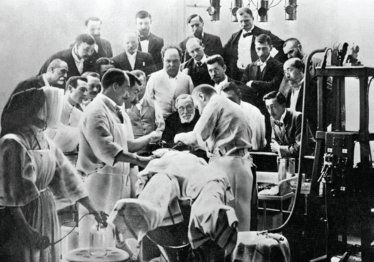
“Rudolf Virchow observing an operation, Berlin” by Wellcome Images is licensed under CC BY 4.0.
Medical education
A dedicated teacher, Virchow used his influential position to revolutionize the teaching of medical students by advocating autopsies and the use of microscopy. He encouraged medical students to “think microscopically” and to “use their knowledge of normal anatomy, histology, and physiology in their study of pathology and in the clinics.” His interest in the causes of disease led to new concepts, such as zoonoses, when he convincingly showed that certain diseases could be transferred from animals to humans. His classical study in this field was delineating the life cycle of Trichinella spiralis, a key contribution to parasitology.
Pathophysiology
Teaching (and learning) of disease phenomena in the early 19th century was mainly based on direct practice. There, observations and reflections constituted a curriculum. A conceptual grasp of the practical clinical situation, as seen by the doctor, yielded a case description. But such simple conceptualization was short of broader theoretical insights and the frameworks of body functions. The doctors of this era catalogued the signs and symptoms of illnesses and observed diseases’ natural histories. They described the appearance of organs and tissues after death, but had no coherent explanation for the fundamental causes of disease.
Enter Rudolf Virchow. From his unique vision of integrating all facets of relevant knowledge, our modern concept of disease physiology was born. Virchow laid out a formal program for medical advancement based on understanding pathologic anatomy and physiology. His words are worth quoting “… The standpoint, which we aim to abide, is a scientific one. Clinical medicine as applied theoretical discipline, theoretical medicine as pathological physiology is the ideal, which we shall strive to realise as far as it is in our power.” Thus, he foresaw “… the cooperation of many painstaking investigators – a pathologic physiology which will be the stronghold of scientific medicine.”
Equally important was his new journal, Archiv für pathologische Anatomie und Physiologie und für klinische Medizin (“Archives of Pathological Anatomy and Physiology and of Clinical Medicine”), later renamed Virchows Archiv. The title itself expressed Virchow’s credo that morphological, functional, and clinical data should be integrated into one corpus of current medical knowledge – a belief that remains his most crucial contribution to the biomedical sciences. He was the journal’s editor until his death and, in it, he published the most important original research papers from that era of early scientific medicine.
Was Virchow also the first molecular pathologist? Perhaps. He said, “Every anatomical alteration is also physical, but does this necessarily mean that every physical alteration is always anatomical? Instead, can’t it be molecular? These subtle molecular changes are not the subject of anatomy, but rather of physiology. They are purely functional.” In this way, he informed our ongoing understanding of body functions and laid the foundations of modern integrative pathophysiology.
Social medicine
In 1848, 27-year-old Virchow was sent by the Prussian government to investigate a typhus epidemic among the weavers of Upper Silesia. His work convinced him that the epidemic was related to the weavers’ horrible working conditions – and, for the first time, he realized that social factors could cause or contribute to disease. From there, Virchow developed a sociological theory of disease – and was inspired to fight for social medicine, insisting that every individual had the constitutional right to health and that society was responsible for providing the necessary sanitary conditions for the unhampered development of its members.
Following his experiences in Upper Silesia, Virchow realized that many diseases could be eliminated through appropriate changes in the society. As a result, he became engaged in politics and was elected to the German parliament, where he irritated Chancellor Bismarck with his requests for social change and improved population health. But all’s well that ends well – and Virchow’s quest ultimately led to universal health care in Germany well before many other countries had similar services.
Virchow was also an avid student of archeology and became the cofounder of the German Society for Anthropology, Ethnology, and Prehistory. He participated in archeological expeditions, helped build several museums, and performed several studies on the ethnicity of the German people. After a nationwide racial study of schoolchildren, Virchow concluded that there was no pure German race but a mixture of different morphological types – a daring rebuttal of nascent theories on German superiority. It’s clear that, in every way, Rudolf Virchow was what all doctors should be – a true man of the people.
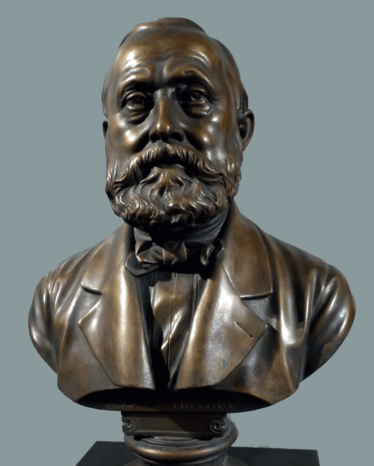
“Rudolf Virchow-Neues Museum” by Ji-Elle is licensed under CC BY-SA 3.0.
Professor Emeritus of Pathology at the University of Kansas, Kansas City, USA.
Retired Professor of Pathophysiology and Internist at the University of Zagreb School of Medicine and Founder and Principal Advisor of the Dubrovnik Summer School of Pathophysiology, Centre for Advanced Academic Studies, Croatia.







